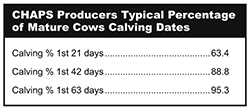
Kris Ringwall
Beef Talk
Get a firm grasp of your calving distribution.
Reviewing cow herd reproduction dates is important. Typically, 85% or more of all cows should be calved within 42 days of the start of the calving season. During the many upcoming winter meetings, the number of cows calving within the first 21 days of the calving season or the first-cycle conception rate will be mentioned often.
Do you know yours? The number means a lot because early-born calves grow well. These calves are indicative of good reproductive success and ultimately add pounds to the truck. However, care needs to be taken to make sure one always is comparing the numbers presented at meetings with one’s own production numbers.
 Generally, the standard numbers referred to are easy to calculate and include more than the number of cows calving within the first 21 days of the calving season. As with most numbers, saying they are easy to calculate is not always true.
Generally, the standard numbers referred to are easy to calculate and include more than the number of cows calving within the first 21 days of the calving season. As with most numbers, saying they are easy to calculate is not always true.
For example, often the overall reproductive success of a herd is calculated as a percentage of cows pregnant and percentage of cows calving. These numbers are common numbers printed by cattle performance programs or simply calculated by hand.
The North Dakota State University (NDSU) Extension Service publishes annual numbers that serve as benchmarks for those who utilize the CHAPS (Cow Herd Appraisal Performance Software) program. These numbers are collected with the help of the North Dakota Beef Cattle Improvement Association (NDBCIA).
Typical values for the percentage of cows pregnant are 93.5%. Of those cows, 92.9% calve. This means of all the cows exposed to the bull, a little more than 7% of the cows never calve. In terms of overall evaluation of the cow herd, these numbers are good comparative numbers to see how one herd ranks against another.
Most herds cull the open cows, make managerial adjustments and anticipate a better calf crop the next year. These good managerial efforts help keep some positive reproductive pressure on the herd. Reproduction, considered by many to be a lowly heritable (in other words, genetic selection has less impact than environmental effects or general management) trait, is fairly stable in most herds pending any detrimental health effects.
Calculation
Returning to the ease of calculation, both of these numbers need accurate breeding cow inventories to be accurate. Often, the number of cows exposed to the bull is not available. Given the traditional way to look at reproduction, another method is available, which is to develop a calving distribution table.
At first glance, calving distribution may seem harder to calculate. However, the neat feature of these numbers is that a producer doesn’t need to know the number of cows exposed. You simply are dealing with the number of cows calving and recorded in the calving book. The calving distribution table allows a producer to follow how cows are calving within the calving season as well as the percentage that is calving in 21, 42 or 63 days or more.
These percentages again can be compared against the benchmarks for overall herd evaluation or utilized to follow how individual cows calve within the herd. The CHAPS benchmark for the percentage of cows calving within the first 21-day period of the calving season is 63.4%.
The calving season is said to start when the third mature cow calves or calculated based on a known bull-turnout date, utilizing a 283-day average gestation length. The percentage of cows calving in the first 42 days of the calving season is 88.8%, and 95.3% in the first 63 days of the calving season.
Figuring from the calving book
If a producer doesn’t have the CHAPS program, the calculations are easy to figure directly from the calving book. Count the total number of mature cows (not including heifers) that calved and note that number on a separate sheet of paper. Then go down the calving book and highlight or circle the date the third mature cow calved.
Then count down 21 days from when the third mature cow calved and draw a line. Also draw a line at 42 and 63 days after the third mature cow calved. By counting the number of cows in each segment of the calving book and dividing by the total number of mature cows in the calving book, the percentage of cows calving at 21, 42 and 63 days is calculated.
The first-calf heifers are not included in these calculations because oftentimes the bull turnout dates or artificial insemination days are quite different from those of the mature cows.
Know your facts and you will enjoy the winter meetings.
May you find all your ear tags.
Author's note: Your comments are always welcome at www.BeefTalk.com. For more information, contact the North Dakota Beef Cattle Improvement Association (NDBCIA) Office, 1041 State Ave., Dickinson, ND 58601, or go to www.CHAPS2000.com on the Internet.











